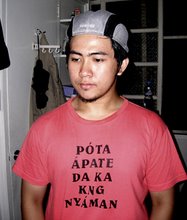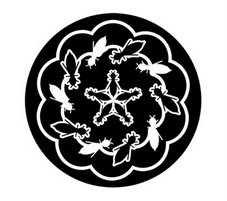By Robby Tantingco
Peanut Gallery
A FRIEND of mine went up to Mount Arayat, hiked past the White Rock to reach the summit, and got lost. He was supposed to go down by nightfall but according tohim, he wandered round and round the mountaintop and kept coming back to where he had been. He managed to find his way down only the following day.
Quite dehydrated and hallucinating, he talked aboutseeing strange lights guiding (or misguiding) himthrough the night, and hearing whispers and othercreepy sounds. He swore that the mountain was enchanted, thus echoing what others before him have concluded. In fact, our ancestors who climbed the mountain and lived to tell their story probably experienced the same thing, prompting them to weavethe story of Sinukuan.
I climbed Mount Arayat only once but my gaze is always drawn to it practically every waking day of my life.On a clear day you can see details on the slopes, like the gulley that seems to have been formed by a prehistoric violent rush of water from quite possibly a crater lake, and of course the White Rock, which our ancestors thought was the palace of Sinukuan but which is probably the extinct volcano’s lava dome.
E. Aguilar Cruz once wrote that the ancient Kapampangans were really mountain worshippers who putup their settlements around a sacred mountain instead of along riverbanks. If indeed, they had come from the sea, the first thing our ancestors saw was the distantMount Arayat (I proved this when I was on a boat inManila Bay) and they merely stumbled upon Pampanga River on their way to the mountain.
Thus, if our ancestors worshipped Mount Arayat, they must have built a temple around it, or on its slopes, or maybe on top of it -- so I thought. Borubodur and the Angkor Wat temples were hidden in the jungle for many centuries before they were discovered. My theory was bolstered when my friend who went up and got lost on top of Mount Arayat told me that indeed, he saw a moss-covered structure near the summit that looked like a temple.
My friend was not very good at describing things so he just gave me a very vague description of "a wall made of square stones with adoor in the middle."
How high was it? I asked. High, he replied. How wide? I insisted. Wide, he said. I organized and sent a team of researchers from the Center for Kapampangan Studies to look for this mystery structure on top of Mount Arayat, while I waited in the office all day. I told them to call or text me as soon as they found it, so that we could call our media friends to make the big announcement.
As I waited for them, I did my own research in the archives. Throughout history, Mount Arayat had indeed served as the sanctuary of mystics and hermits as well as a refuge for scoundrels and rebels. The plateau between the White Rock and the summit,which is probably the volcano's caldera (crater), was the hideout and headquarters of the revolutionaries in1897 and 1899; it even had a name: Real de Camansi (Camansi Military Camp).
According to one account, the revolutionaries built on this plateau barracks for the troops, houses and offices, for revolutionary leaders like Gen. Francisco Makabulos and Gen. Servillano Aquino. On November 27, 1897, the Spanish Army under Gen.Ricardo Monet sent more than a thousand troops (Spaniards and Macabebe volunteers) up the mountain toattack the revolutionaries at the Camansi camp.
TheMacabebes were stationed on a boulder near the White Rock. A storm, however, prevented what could have been a massacre of the revolutionaries; instead, the Spanish troops retreated back to Magalang. Throughout the day the Spaniards climbed back to the mountaintop a total of six times, and six times they were repulsed byMakabulos' men.
But the Spaniards continued attacking throughout the stormy night, and by daybreak the camp had fallen. Out of over 2000 revolutionaries, 93 were killed; the rest, including Gen. Makabulos and Gen. Aquino, had escaped. Aquino was captured later in SanFernando and was executed at Fort Santiago.
Makabulos survived the Revolution but fought again during the Philippine-American War, surrendered toGen. Arthur McArthur in 1900, and retired as a farmer and poet in La Paz, Tarlac. A few years later, a prisoner-turned- cult leader Felipe Salvador spread his gospel of rain of gold and jewel and redistribution of land” in the region around Mount Arayat, until he was recaptured and publicly hanged.
In the shadow of Mount Arayat, the HUKBALAHAP was organized, and so was its mutant, the Hukbong Mapagpalaya sa Bayan (HMB), as well as all the other communist organizations and armies that engaged the government forces for decades.
Today, the mysticism of Mount Arayat finds expression in a mysterious Rizalista community nestled on its slopes, where long-haired, white-robed members venerate a gallery of saints including an old lady named Sinukuan.
Well, anyway, my research team finally returned from their expedition on Mount Arayat. They reported that they reached only the White Rock and could not go anyfarther because they had lost their way and night was falling. They vowed, though, to return another daybecause they are convinced, something is up there, waiting to be discovered. Maybe not a prehistoric temple, but Gen. Makabulos' military camp. Well, not bad.
Alben meng manyaman, boy!
Subscribe to:
Post Comments (Atom)








2 comments:
Hi!:> Are the Macabebes that you mentioned here the same ones who will form the Macabebe scouts that served in the Phil. American War and WW II?
I do believe Mount Arayat is very sacred mountain. I do believe that our ancestors worship on the top of the stay at mountain. I do believe that the ark of Noah build in that mountain. I do believe that the Garden of Eden is located in that area. Which is guarded by the angel of God.
Post a Comment